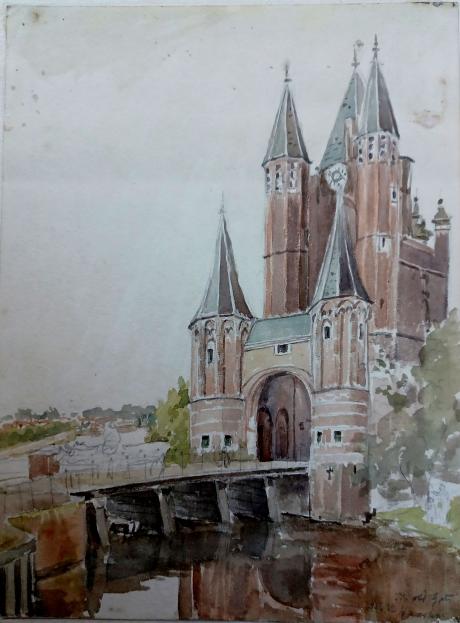Tom and Laura Taylor and thence by descent

The Amsterdamse Poort is an old city gate of Haarlem, Netherlands. It is located at the end of the old route from Amsterdam to Haarlem and the only gate left from the original twelve city gates.
It was created in 1355 and is the only remaining city gate from the defenses of Haarlem. Until the 17th century it was the city gate used for traffic by land eastwards towards Spaarnwoude over the Laeghe weg (now Oude weg). In 1631 the Haarlemmertrekvaart was dug, which shortened the waterway from Haarlem to Amsterdam considerably.


This gate, for those travelling by land, was called the Spaarnwouderpoort. With the new canal and its towpath, the trip was so short, it became much more popular, since it was now possible to travel back and forth to Amsterdam on the same day. Thus the name of the gate changed to Amsterdamse Poort.
In 1865 the city government wanted to demolish the gate. A speedy procedure to put down the gate was requested, as the gate was in pretty bad shape and was blocking the construction of a new bridge on the location just in front of the gate. However, there was not enough money at the moment to construct a new bridge, so the city council agreed to provide funds for a short-term renovation of the gate to make sure it would stay up for two or three more years.
In 1867 the Papentoren, a tower, was demolished, and the munition that had been stored there needed a storage space. A room in the Amsterdamse Poort was suited for that and the munition was stored. In 1869 the bridge in front of the gate was finally reconstructed. In 1874 most of the (explosive) munition was taken outside the city.
In 1889 a small renovation was planned, with a budget of 1,490 guilders. The city architect, J. Leijh, started the project, which later required an extra 775 guilders.
In the 1960s the gate was declared a national monument. In 1985 a complete renovation of the gate took place.
Laura Wilson Barker (6 March 1819 – 22 May 1905), was a composer, performer and artist, sometimes also referred to as Laura Barker, Laura W Taylor or "Mrs Tom Taylor".
She was born in Thirkleby, North Yorkshire, third daughter of a clergyman, the Rev. Thomas Barker. She studied privately with Cipriani Potter and became an accomplished pianist and violinist. As a young girl Barker performed with both Louis Spohr and Paganini. She began composing in the mid-1830s - her Seven Romances for voice and guitar were published in 1837. From around 1843 until 1855 she taught music at York School for the Blind. During this period some of her compositions - including a symphony in manuscript, on 19 April 1845 - were performed at York Choral Society concerts.
On 19 June 1855 she married the English dramatist, critic, biographer, public servant, and editor of Punch magazine Tom Taylor. Barker contributed music to at least one of her husband's plays, an overture and entr'acte to Joan of Arc (1871), and provided harmonisations as an appendix to his translation of Ballads and Songs of Brittany (1865).
Her other works include the cantata Enone (1850), the violin sonata A Country Walk (1860), theatre music for As You Like It, (April 1880), Songs of Youth (1884), string quartets, madrigals and solo songs. Her choral setting of Keats's A Prophecy, composed in 1850, was performed for the first time 49 years later at the Hovingham Festival in 1899. The composer was present.
Several of Barker's paintings hang at Smallhythe Place in Kent, Ellen Terry's house.
Barker lived with her husband and family at 84 Lavender Sweep, Battersea. There were two children: the artist John Wycliffe Taylor (1859–1925), and Laura Lucy Arnold Taylor (1863–1940). The Sunday musical soirees at the house attracted many well-known attendees, including Lewis Carroll, Charles Dickens, Henry Irving, Charles Reade, Alfred Tennyson, Ellen Terry and William Makepeace Thackeray.
Tom Taylor died suddenly at his home in 1880 at the age of 62. After his death, his widow retired to Porch House, Coleshill in Buckinghamshire, where she died on 22 May 1905, aged 86.

